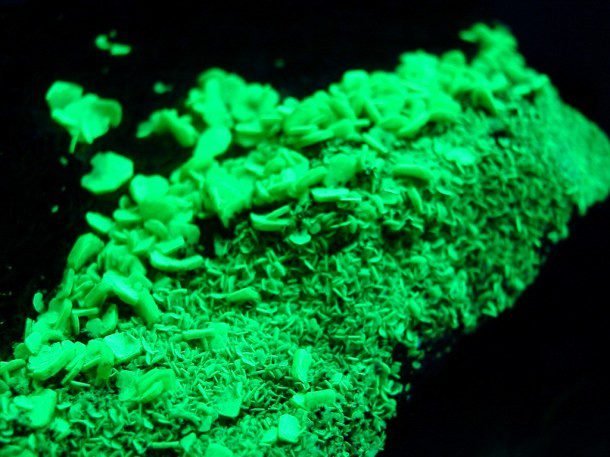Where it comes from and how it’s made the nuclear fuel used in nuclear power plants? It is this post`s subject.
Uranium
In nature, the mineral extracted for nuclear fuel is in form of uraninite, whose chemical formula is UO_{2}.

These are the caronotite (K_2(UO_2)_2(VO_4)\cdot 3H_2O), torbenite (Cu(UO_2)_2(PO_4)_2\cdot 12H_2O) and the autunite (Ca(UO_2)_2(PO_4)_2\cdot 11H_2O) respectively. These minerals are also used to uranium extraction.



The ore extraction can liberate radon gas and contaminate groundwater.
Separation and purification
First, the mineral is crushed and grinded, then the fragments are mixed with water to create a slurry, after that, the slurry is mixed with sulfuric acid (H_2SO_4) or alkaline solution. These are the ore`s reactions with acid.
UO_2+2Fe^{3+}\rightarrow UO_2^{2+}+2Fe^{2+}
UO_3+2H^+\rightarrow UO_2^{2+}+H_2O
UO_2^{2+}+3SO_4^{2-}\rightarrow [UO_2(SO_4)_3]^{4-}
And the ore’s reactions with alcaline solution.
2UO_2+O_2 \rightarrow 2UO_3
UO_3+Na_2CO_3 + 2NaHCO_3 \rightarrow Na_4UO_2(CO_3)^3+H_2O
UO_3+3Na_2CO_3 + H_2O \rightarrow Na_4UO_2(CO_3)^3+2NaOH
This leaching process eliminates waste and heavy metal impurities which are pumped and can be dumped in the environment, even some remains of uranium can be wasted. After the leaching reactions, the uranium oxide is separated by ion exchange or solvent extraction. To later be filtered, dried and stored in barrels.

At the end of the process, is obtained a powder with 80% of U_3O_8, also known as yellowcake.

There is an alternative method to extract this element which will be subject in another post. In nature, there are three types of uranium with different masses, the U-234, U-235, and U-238, however, there is only less than 1% of U-235 in the natural uranium. It is needed between 3% and 5% to nuclear power plants and then enters the uranium enrichment.
Producing the “hex”
Before the enrichment, the yellowcake needs to transform in uranium hexafluoride gas (UF_6), for that, must dissolve the yellowcake with nitric acid to produce uranyl nitrate (UO_2(NO_3)_2\cdot 6H_2O). The impurities are removed with tributyl phosphate and kerosene, then the solution is washed with dilute nitric. The water is vaporized and by thermal decomposition, have the UO_2 ou UO_3. Then, the UO_3 reacts with hydrogen gas in a kiln.
UO_3+H_2\rightarrow UO_2+H_2O
UO_2 reacts with hydrogen fluorite to form UF_4 and reacts with fluoride gas to form the UF_6, known as hex.
UO_2+4HF\rightarrow UF_4+2H_2O
UF_4+F_2\rightarrow UF_6
Enrichment by gas diffusion
In this process, the gas UF_6 pass by a tube with high pressure, the gas with U-235 passes by the tube`s porous membrane more easily for be smaller.


Enrichment by ultracentrifugation
The hex is put in a high-speed centrifuge, when the centrifuge spins, the heavier molecules, which have U-238, stay further from the center. While the lightest, with U-235, stay closer to the center.

This is the most used method to enrich uranium because gas diffusion consumes too much electrical energy.
Enrichment by laser
A dioxide carbon gas infrared laser pulsing in the resonance frequency of U-235 is triggered in direction to the hex cooled and in high speed. The gas molecules with U-235 lose electrons and behave differently than molecules with U-238.

This technique promises to save energy and space.
Producing the bars
Finally, the stage to produce bars which will be used in reactors. The enriched hex must be converted into an oxide uranium powder. First, hex reacts with steam.
UF_6+2H_2O\rightarrow UO_2F_2+4HF
The UO_2F_2 reacts with hydrogen gas and water at 700 ºC.
3UO_2F_2+2H_2O+H_2\rightarrow U_3O_8+6HF
The result is the oxide uranium powder U_3O_8.

The powder is pressed to form pellets after that is heated between 1600 ºC and 1700 ºC to gain consistency. And finally, the pellets are stacked in tubes made of zircon or steel to use in reactors.




